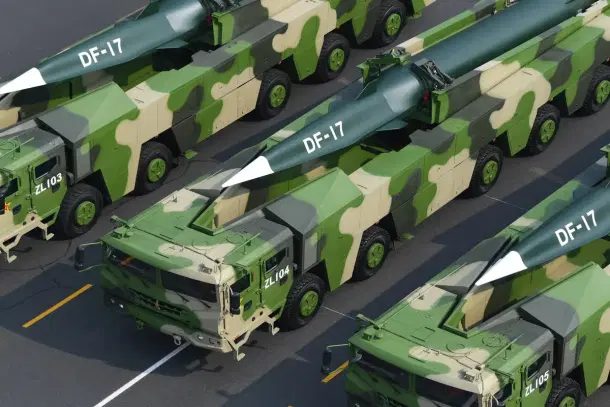Defence
China Created World's First 'Near-Space Command': Here Is What We Know So Far
Ujjwal Shrotryia
Nov 23, 2023, 02:26 PM | Updated 02:36 PM IST
Save & read from anywhere!
Bookmark stories for easy access on any device or the Swarajya app.


China has reportedly established the world’s first 'near-space command,' equipped with powerful hypersonic weapons, according to Hong Kong’s SCMP.
According to the report, the new force will serve as the People’s Liberation Army’s fifth force, alongside the Army, Navy, Air Force, and Rocket Force.
But What is Near Space?
Near Space refers to the area in Earth's atmosphere, approximately 20 to 100 kilometres from the Earth's surface, known as the mesosphere.
In this region, air is very thin, preventing traditional military aircraft from flying, and gravity is strong enough to prevent satellites from remaining in orbit, creating a No-Man's land region.
However, hypersonic missiles can easily operate in this area due to the rarefied atmosphere, enabling them to fly at hypersonic speeds for long ranges.
The characteristics of the near-space region are what the Chinese hope to exploit using the 'near-space' command.
Status of the Near-Space Command
According to the SCMP report, Chinese researchers believe that space is the next battleground, and dominating near-space will provide China with an edge in future wars.
China aims to develop a comprehensive advantage over its competitors in this near-space domain.
A research paper submitted to the 11th China Command and Control Conference in October stated that near-space had become a hotly contested zone that could "determine the outcome of future battles."
"It is not clear when the near-space command was formed, but according to the report, it is still in the developmental stage. The establishment of relevant units is not yet mature, and combat operations have not been standardised," the report said.
What weapons will the Near-Space Command have at its disposal?
The Near-Space Command will primarily consist of hypersonic weapons owned by all branches of the PLA military—army, navy, air force, and rocket forces.
In the event of war, control over these hypersonic weapons will be transferred directly to the near-space command.

The command will also deploy a large number of spy balloons, solar-powered long-endurance drones, and other associated equipment.
Who will have command and control over the near-space command?
The near-space command will report directly to the highest level of the military due to its potential to invite political or military backlash from major geopolitical powers like the US, EU, India, or Russia.
That is why, “It is necessary to adjust the hierarchy of command and control powers, selection of command methods, implementation of executive orders and support for command communication,” the report said quoting the researchers.
The report added, "The understanding of near-space combat command needs to be deepened."
How will Near-Space Command help China win 'Future Wars'?
According to the report, in the event of future wars, the near-space command will be tasked with carrying out 'merciless' attacks on critical targets and conducting high-altitude surveillance globally through automated drones and spy balloons.
The space command will first identify enemy anti-satellite missile launch sites and destroy them, preventing the enemy from interfering with Chinese civilian or military satellite infrastructure.
“These attacks must be precise, overwhelming and merciless,” the report says. These targets will be hit at an unstoppable speed, using hypersonic missiles, surprising the enemy.
"The loss of critical infrastructure in the early stages of a conflict would break down an enemy’s war machine and severely affect its ability and willingness to fight," the report said, predicting the initial course of war with a future enemy.
“This could change the pace of battles and bring a major impact to how a war would end,” the Chinese researchers believe.
The report further states, "The success of the war in near-space would be to a large extent based on innovative strategies and combat tactics grounded in an in-depth analysis of the enemy’s weaknesses."
Also Read: Pentagon Reacts To Media Report On Chinese Spy Balloon's Surveillance Of US Military Sites
Doors Shut For High-Altitude Chinese Spy Balloons In Indian Skies; SOPs Framed To Shoot Them Down
After Shooting Down Chinese Spy Balloon, US Shared Tactics With India On Dealing With Such Threats
Staff Writer at Swarajya. Writes on Indian Military and Defence.





